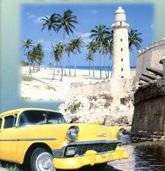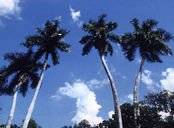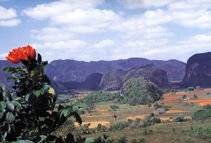TO CUBA
WITH
USA CUBA

|
TO CUBA WITH USA CUBA |
 |
| Welcome
About us Travel tips SPECIALTIES
BUSINESS
PRODUCTS
FEEDBACK
ABOUT CUBA
TRAVEL INDUSTRY
NOTICE
FOR
|
 General
information General
information
Overview of Cuba - Travel Guide The Cuban Archipelago is located in the Caribbean Sea, just beside the Tropic of Cancer, and right at the mouth of the Gulf of Mexico, between North and South America. It is 140 km (87 miles) from the Bahamas, 146 km (91 miles) from Jamaica, 180 km (112 miles) from Florida, and 210 km (131 miles) from Cancun. Cuba itself is the largest island in the West Indies with a surface area of 110,922 square kilometers (42,827 miles2); the archipelago includes the island of Cuba, the Isle of Youth (also known as Isle of Pines), and about 4,195 keys and islets. The island of Cuba is long and narrow.
It is 1,200 km (746 miles) long and its irregular coast-line comprises
a total length of 5,746 km (3,571 miles). It offers more than 200 bays
and over 300 natural beaches.
The Republic of Cuba is divided into fourteen provinces and the special municipality of the Isle of Youth. The provinces are Pinar del Rio, La Habana, Ciudad de La Habana (the City of Havana), Matanzas, Cienfuegos, Villa Clara, Sancti Spiritus, Ciego de Avila, Camaguey, Las Tunas, Holguin, Granma, Santiago de Cuba and Guantanamo. Cuba has a tropical climate, but with
no extreme temperatures since it is cooled by the gentle breezes of the
trade winds. It has two clearly defined seasons, the rainy season from Royal palm trees, coconut palms, sugarcane,
and tropical fruit trees are all very common on the island. Cuba
features some of the richest insular flora in the world. More than
50% is endemic. There are no animals that represent a danger to human
beings. There are about Christopher Columbus arrived in Cuba
on October 27, 1492, somewhere around Cayo Bariay (Holguin), whose natural
beauty made him exclaim: "It is the most beautiful...[island]!" The
processes of conquest and colonization were initiated early in the sixteenth
century by Diego Velázquez, who was the founder of the first seven
townships: Baracoa, Bayamo, Santiago de Cuba, Trinidad, Sancti Spiritus,
Puerto Principe (today's Camaguey), and San Cristóbal de La Habana. After the extermination of the native population, slave traders began to import Africans, who represent the second largest component of the Cuban nationality, which came into existence, so to speak, in the nineteenth century. The history of the island was marked by ongoing struggles for independence, beginning with the War of Independence of 1868 continuing through the most recent revolutionary endeavors of the present century, and reaching a climax with the victory of the Revolution on January 1, 1959. National Holidays are;

The Cuban trogon, another endemic species, is the national bird. Its feathers have the same colors as the Cuban national flag. The royal palm is considered the national tree. Though not originally from Cuba, it is a widespread species. The royal palm has a great deal of symbolic significance for Cubans. Sugarcane and its related industries
form the fundamental basis of Cuba's economy. Other traditional crops include
tobacco, Education is free at all levels. According to the Cuban government, illiteracy has been completely eradicated. Cuba has dozens of centers for higher learning. There are more than 3,000,000 students registered in the national educational system. There are universities or faculty departments, high schools, special schools for the handicapped, technical schools and other kinds of educational facilities in every province. The school year begins in September and ends in June.
Cuban life is characterized by a wide variety of cultural activities. Literature, fine arts, cinema, ballet, contemporary dance and drama have all provided Cuban culture with internationally renowned figures. The island play host to many regional and international cultural events. The National Institute for Sports,
Physical Education, and Recreation (INDER) manages and promotes sports
activities in Cuba. The country has become a regional sports power.
It is among the world's leading nations in There is now religious freedom in Cuba. Roman Catholicism is the most widely practiced faith. All over the country, there are many churches where religious services take place daily. Afro-Cuban religions are deeply rooted in Cuban culture. They have arisen from a blending of African pantheons and Catholic saints. Members of various Protestant denominations also have the right to worship according to their customs and traditions.
 Old-gold
dry and extra-aged rums are best for drinking straight up or on the rocks.
For cocktails, light dry and silver dry are ideal. The most famous
Cuban cocktails served in most bars are Cuba Libre, Mojito, Daiquiri, Daiquiri
Mulata, Havana Special, Piña Colada, Cubanito, Isla de Pinos (Isle
of Pines), Presidente, Saoco, and Cuba Bella. Old-gold
dry and extra-aged rums are best for drinking straight up or on the rocks.
For cocktails, light dry and silver dry are ideal. The most famous
Cuban cocktails served in most bars are Cuba Libre, Mojito, Daiquiri, Daiquiri
Mulata, Havana Special, Piña Colada, Cubanito, Isla de Pinos (Isle
of Pines), Presidente, Saoco, and Cuba Bella.
Updated August
20, 2000
Copyright ©2000 USA CUBA TRAVEL |